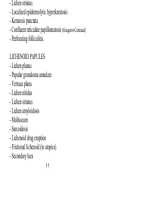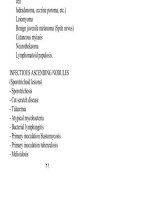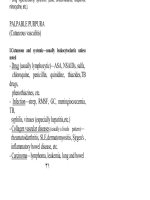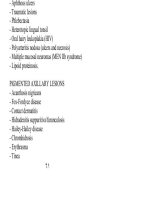Ebook Manual of cardiac diagnosis Part 2
Bạn đang xem bản rút gọn của tài liệu. Xem và tải ngay bản đầy đủ của tài liệu tại đây (38.97 MB, 467 trang )
Intravascular Coronary
Ultrasound and Beyond
CHAPTER
12
Teruyoshi Kume, Yasuhiro Honda, Peter J Fitzgerald
Chapter Outline
• Intravascular Ultrasound
–– Basics of IVUS and Procedures
–– Normal Vessel Morphology
–– IVUS Measurements
–– Tissue Characterization
–– Insights into Plaque Formation
and Distribution
–– Interventional Applications
–– Preinterventional Imaging
–– Balloon Angioplasty
–– Bare Metal Stent Implantation
–– Drug-eluting Stent Implantation
–– Safety
–– Future Directions
• Optical Coherence Tomography
–– Imaging Systems and Procedures
–– Image Interpretation
–– Clinical Experience
–– Detection of Vulnerable Plaque
–– Safety and Limitations
–– Future Directions
• Angioscopy
–– Imaging Systems and Procedures
–– Image Interpretation
–– Clinical Experience
–– Detection of Vulnerable Plaque
–– Safety and Limitations
–– Future Directions
• Spectroscopy
–– Imaging Systems and Procedures
–– Experimental Data
–– Clinical Experience
–– Safety and Limitations
–– Future Directions
INTRODUCTION
Intravascular ultrasound (IVUS) is widely used as a major
diagnostic and assessment technique that provides detailed crosssectional imaging of blood vessels in the cardiac catheterization
laboratory. The first ultrasound imaging catheter system was
developed by Bom and his colleagues in Rotterdam, the
Netherland, in 1971.1 By the late 1980s, the first images of human
vessels were recorded by Yock and his colleagues.2 Since then,
IVUS has become a pivotal catheter-based imaging technology
that can provide scientific insights into vascular biology and
practical guidance for percutaneous coronary interventions
(PCIs) in clinical settings. In this chapter, IVUS and the other
catheter-based imaging devices—optical coherence tomography
(OCT), angioscopy and spectroscopy—are described. These
newly developed imaging technologies provide supplemental
and unique insights into vascular biology as well.
INTRAVASCULAR ULTRASOUND
Basics of IVUS and Procedures
The IVUS imaging systems use reflected sound waves
to visualize the vessel wall in a two-dimensional format
analogous to a histologic cross-section. In general, higher
frequencies of ultrasound limit the scanning depth but improve
the axial resolution, and current IVUS catheters used in the
coronary arteries have center frequencies ranging 20–45 MHz.
434
Manual of Cardiac Diagnosis
There are two different types of IVUS transducer systems:
(i) the solid-state dynamic aperture system (the electronically
switched multi-element array system) and (ii) the mechanically
rotating single-transducer system (Table 1 and Figs 1A and B).
Several types of artifacts can be observed common or unique to
each system (Figs 2A to D). With both systems, still frames and
video images can be digitally archived on local storage memory
or a remote server using digital imaging and communications in
medicine (DICOM) Standard 3.0. Regardless of IVUS system
used in the patient, both require preprocedural administration
of intravenous heparin (5,000–10,000 U), or equivalent
anticoagulation along with intracoronary nitroglycerin (100–300
µg), to reduce the potential for coronary spasm.
Normal Vessel Morphology
The interpretation of IVUS images is possible as the layers of
a diseased arterial wall can be identified separately. Particularly
in muscular arteries, such as the coronary tree, the media of
the vessel is characterized by a dark band compared with the
intima and adventitia (Figs 3A and B). Differentiation of the
layers of elastic arteries, such as the aorta and carotid, can be
problematic because media are less distinctly seen by IVUS.
However, most of the vessels currently treated by catheter
techniques are muscular or transitional arteries. These include
the coronary, iliofemoral, renal and popliteal systems. Therefore,
it is usually easy to identify the medial layer.
FIGURES 1A AND B: Diagrams of two basic imaging catheter designs:
(A) solid state and (B) mechanical. (A: bottom) an image obtained using
a solid-state catheter imaging system. (B: bottom) an image obtained
using a mechanical catheter imaging system
Intravascular Coronary Ultrasound and Beyond
TABLE 1
Comparison of two IVUS designs
Basics
Products
Features
Image quality
Artifacts
Solid-state dynamic
aperture system
An electronic solid state
catheter system with
multiple imaging elements
at its distal tip, providing
cross-sectional imaging
by sequentially activating
the imaging elements in a
circular way
One system is
commercially available
(Volcano Corporation,
Inc., Rancho Cordova,
CA)
Mechanically rotating
single-transducer system
A mechanical system that
contains a flexible imaging
cable which rotates a
single transducer at its tip
inside an echolucent distal
sheath
Several systems are
commercially available
(Boston Scientific
Corporation, Natick, MA;
Volcano Corporation,
Inc., Rancho Cordova,
CA; Terumo Corporation,
Tokyo, Japan)
The imaging catheter has The imaging catheter
64 transducer elements
uses a 40- or 45 MHz
arranged around the
transducer with a distal
catheter tip and uses a
crossing profile of 3.2
center frequency of 20
Fr (compatible with 6 Fr
MHz
guide catheters)
The outer shaft diameter
of IVUS catheters
in a rapid-exchange
configuration is 2.9 Fr and
thus compatible with a 5
Fr guide catheter
This imaging catheter has Higher frequencies
better scanning depth but improve the axial
poorer axial resolution
resolution. Therefore,
compared with the
mechanical transducers
mechanical systems
have traditionally offered
advantages in image
quality compared with the
solid-state systems
The guidewire runs inside The guidewire runs
the IVUS catheter thereby outside the IVUS catheter,
preventing guidewire
parallel to the imaging
artifact
segment, resulting in
guidewire artifact
This system does not
This system requires
require flushing with
flushing with saline before
saline
insertion to eliminate
any air in the path of the
beam. Incomplete flushing
artifact may result in poor
image quality
Contd...
435
436
Manual of Cardiac Diagnosis
Contd...
Solid-state dynamic
aperture system
Mechanically rotating
single-transducer system
This system eliminates
nonuniform rotational
distortion (NURD)
Others
The NURD can occur
when bending of the
drive cable interferes
with uniform transducer
rotation, causing a wedgeshaped, smeared image
to appear in one or more
segments of the image
Since the solid-state
The imaging catheters
transducer has a zone
have excellent near-field
of “ring-down artifact”
resolution and do not
encircling the catheter, an
require the subtraction of
extra step is required to form a mask
a mask of the artifact and
subtract this from the image
Short transducer-toThe pullback trajectory is
tip distance (10.5 mm)
stabilized and it reduces
facilitates visualization of the risk of a nonuniform
distal coronary anatomy
speed in a continuous
pullback
The relative echolucency of media compared with intima
and adventitia gives rise to a three-layered appearance
(bright-dark-bright), first described in vitro by Meyer and his
colleagues.3 Due to the lack of collagen and elastin compared
to neighboring layers, the media displays lower ultrasound
reflection. “Blooming”, a spillover effect, is seen in the IVUS
image because the intimal layer reflects ultrasound more strongly
than the media. This results in a slight overestimation of the
thickness of the intima and a corresponding underestimation of
the medial thickness. On the other hand, the media/adventitia
border is accurately rendered, because a step-up in echo
reflectivity occurs at this boundary and no blooming appears.
The adventitial and periadventitial tissues are similar enough
in echoreflectivity that a clear outer adventitial border cannot
be defined.
Several deviations from the classic three-layered appearance
are encountered in clinical practice. The echoreflectivity
of the intima and internal lamina may not be sufficient to
resolve a clear inner layer in truly normal coronary arteries
from young patients. This is particularly true when the media
has a relatively high content of elastin. However, most adults
seen in the cardiac catheterization laboratory have enough
intimal thickening to show a three-layered appearance, even
in angiographically normal segments. At the other extreme,
patients with a significant plaque burden have thinning of the
media underlying the plaque. As a result, the media is often
indistinct or undetectable in at least some part of the IVUS
Intravascular Coronary Ultrasound and Beyond
FIGURES 2A TO D: Common IVUS image artifacts: (A) A “halo” or
a series of bright rings immediately around the mechanical IVUS
catheter is usually caused by air bubbles that need to be flushed out.
(B) Radiofrequency noise appears as alternating radial spokes or
random white dots in the far-field. The interference is usually caused
by other electrical equipment in the cardiac catheterization laboratory.
(C) Nonuniform rotational distortion (NURD) results in a wedge-shaped,
smeared appearance in one or more segments of the image (between
12 O’clock and 3 O’clock in this example). This may be corrected by
straightening the catheter and motor drive assembly, lessening tension
on the guide catheter, or loosening the hemostatic valve of the Y-adapter.
(D) Circumferential calcification causes reverberation artifact between
10 O’clock and 1 O’clock
cross-section. This problem is exacerbated by the blooming
phenomenon. Even in these cases, however, the inner adventitial
boundary (at the level of the external elastic lamina) is always
clearly defined. For this reason, most IVUS studies measure
and report the plaque-plus-media area as a surrogate measure
for plaque area alone. The addition of the media represents
only a tiny percentage increase in the total area of the plaque.
The determination of the position of the imaging plane
within the artery is one important aspect of image interpretation.
For example, an IVUS beam penetrates beyond the coronary
artery, providing images of perivascular structures, including
the cardiac veins, myocardium and pericardium (Figs 4A to
C). These structures provide useful landmarks regarding the
position of the imaging plane because they have a characteristic
appearance when viewed from various positions within the
arterial tree. The branching patterns of the arteries are also
437
438
Manual of Cardiac Diagnosis
FIGURES 3A AND B: Cross-sectional format of a representative IVUS
image. The bright-dark-bright, three-layered appearance is seen in the
image with corresponding anatomy as defined. The “IVUS” represents
the imaging catheter in the vessel lumen. Histologic correlation with
intima, media and adventitia are shown. The media has lower ultrasound
reflectance owing to less collagen and elastin compared with neighboring
layers. Since the intimal layer reflects ultrasound more strongly than the
media, there is a spillover in the image, resulting in slight overestimation
of the thickness of the intima and a corresponding underestimation of
the medial thickness
distinctive and help to identify the position of the transducer.
In the left anterior descending (LAD) coronary artery system,
for example, the septal perforators usually branch at a wider
angle than the diagonals. On the IVUS scan, the septals appear
to bud away from the LAD much more abruptly than the
diagonals (Figs 5A to D). The branching pattern and perivascular
landmarks, once understood, can provide a reference to the
actual orientation of the image in space.
IVUS Measurements
The IVUS images have an intrinsic distance calibration, which
is usually displayed as a grid in the image. Electronic caliper
(diameter) and tracing (area) measurements can be performed
at the tightest cross section, as well as at reference segments
located proximal and distal to the lesion.
In everyday clinical practice, where accurate sizing of
devices is needed, vessel and lumen diameter measurements
are important. The maximum and minimum diameters (i.e. the
major and minor axes of an elliptical cross-section) are the most
widely used dimensions. The ratio of maximum to minimum
diameter defines a measure of symmetry. Area measurements are
performed with computer planimetry; lumen area is determined
FIGURES 4A TO C: Perivascular landmarks: (A) The great cardiac vein (GCV), running superiorly to the left circumflex coronary artery (LCx), appears as a
large, low-echoic structure with fine blood speckle. Recurrent atrial branches emerge from the LCx in an orientation directed toward the GCV, whereas the
obtuse marginal branches emerge opposite the GCV and course inferiorly to cover the lateral myocardial wall. (B) In the proximal portion of the left main
coronary artery, a clear echo-free space filled with pericardial fluid, called the transverse sinus, is found adjacent to the artery, immediately outside of the left
lateral aspect of the aortic root. (C) At the level of the middle right coronary artery, the veins arc over the artery, typically at a position just adjacent to the right
ventricular marginal branches
Intravascular Coronary Ultrasound and Beyond
439
440
Manual of Cardiac Diagnosis
FIGURES 5A TO D: Pullback imaging sequence from mid to proximal
portion of the left anterior descending (LAD) artery: (A) The mid and
distal portions of the LAD often lie deeper in the sulcus than the proximal
LAD and myocardium may be observed. The pericardium is seen at the
opposite site of myocardium. (B and C) The septal branches emerge
opposite to the pericardium, but the diagonal branches take off more
superiorly. The angle between the septal and the diagonal branches
usually increases to as much as 180 degrees. (D) The left circumflex
artery emerges on the same side as the emergence of the diagonal
branches
by tracing the leading edge of the blood/intima border, whereas
vessel or external elastic membrane (EEM) area is defined as
the area enclosed by the outermost interface between media and
adventitia. Plaque area or plaque-plus-media area is calculated
as the difference between the vessel and lumen areas; the ratio
of plaque to vessel area is termed percent plaque area, plaque
Intravascular Coronary Ultrasound and Beyond
burden or percent cross-sectional narrowing. Area measurements
can be added to calculate volumes using Simpson’s rule with
the use of motorized pullback. In general, the investigator
selects the most normal-looking cross-section (i.e. largest lumen
with smallest plaque burden) occurring within 10 mm of the
lesion with no intervening major side branches as the reference
segment.4
Tissue Characterization
The IVUS can provide detailed information about plaque
composition. Regions of calcification are very brightly echoreflective and create a dense shadow more peripherally from
the catheter, a phenomenon known as “acoustic shadowing”
(Figs 6A to C). Shadowing prevents determination of the true
thickness of a calcific deposit and precludes visualization of
structures in the tissue beyond the calcium. Reverberation is
another characteristic finding with calcification. It causes the
appearance of multiple ghost images of the leading calcium
interface, spaced at regular intervals radially (Fig. 2D). Like
calcium, densely fibrotic tissue appears bright on the ultrasound
scan. Fatty plaque is less echogenic than fibrous plaque.
The brightness of the adventitia can be used as a gauge to
discriminate between predominantly fatty from fibrous plaque.
Therefore, an area of plaque that appears darker than the
adventitia is fatty. In an image of extremely good quality, the
presence of a lipid pool can be inferred from the appearance of
a dark region within the plaque (Figs 7A and B). Furthermore,
the “hot” lesions like ruptured plaques responsible for unstable
angina or acute coronary syndromes can be observed by IVUS
(Figs 8A and B).
Recently, the clinical impact of attenuated plaques characteri
zed as hypoechoic plaque with ultrasound attenuation despite
little evidence of calcium has been reported (Figs 9A to C).
These specific plaques are more often seen in patients with
acute coronary syndromes than in those with stable angina and
are characterized by positive remodeling and nearby calcifica
tion.5 Clinical studies have indicated that attenuated plaques
are associated with no reflow and creatine kinase-MB elevation
after PCI because of distal embolization.6,7 This novel defined
plaque may contain microcalcification, thrombus or cholesterol
crystals.8
Visual interpretation of conventional grayscale IVUS
images is limited in the detection and quantification of specific
plaque components. Therefore, computer-assisted analysis of
raw radiofrequency (RF) signals in the reflected ultrasound
beam has recently been developed (Figs 10A to C). Virtual
Histology™ (VH) IVUS (Volcano Corporation, Rancho
441
FIGURES 6A TO C: Examples of coronary calcification: (A) Superficial calcification is seen between 6 O’clock and 10 O’clock. The deeper vessel structure is
obscured by the shadowing of the calcium layer (acoustic shadowing: asterisk). (B) Deep deposit of calcium is seen in a rim of fibrous plaque. (C) There are
superficial and deep calcium deposits with acoustic shadowing
442
Manual of Cardiac Diagnosis
Intravascular Coronary Ultrasound and Beyond
FIGURES 7A AND B: Atherosclerotic plaque with lipid pool. Lipid
pool is defined as an echolucent area within the plaque and observed
at 8-2 O’clock in this IVUS image
FIGURES 8A AND B: Example of plaque rupture. On the cross-sectional
IVUS images (A), a cavity in contact with the vessel lumen is observed.
The longitudinal IVUS image (B) shows a spatial representation of the
plaque rupture. The rupture occurs in an eccentric plaque and has a
residual thin flap that probably corresponds to a thin fibrous cap
Cordova, California,) is recognized as the first commercialized
RF analysis technology. A classification algorithm developed
from ex vivo human coronary data sets can generate colormapped images of the vessel wall with a distinct color for each
category: fibrous, necrotic, calcific and fibro-fatty.9 Another
mathematical technique used in RF ultrasound backscatter
analysis is Integrated Backscatter (IB) IVUS (YD Corporation,
Nara, Japan). This method utilizes IB values, calculated as the
average power of the backscattered ultrasound signal from a
sample tissue volume. The IB-IVUS system constructs colorcoded tissue maps, providing a quantitative visual readout as
443
FIGURES 9A TO C: Examples of attenuated plaques. Attenuated plaque was defined as plaque with deep ultrasonic attenuation despite absence of bright calcium
444
Manual of Cardiac Diagnosis
Intravascular Coronary Ultrasound and Beyond
FIGURES 10A TO C: Color-mapped images of the coronary plaque.
Conventional grayscale IVUS images (left). (A) Virtual Histology ™ shows
a distinct color for each of the fibrous, necrotic, calcific and fibro-fatty.
(B) Integrated Backscatter-IVUS can provide a quantitative visual readout
as four types of plaque composition: calcification, fibrous, dense fibrosis
and lipid pool. (C) iMap™ allows identification of four different types of
plaque components (fibrotic, necrotic, lipidic and calcified tissue) with
a confidence level assessment of each plaque component. (Source:
Figure A Dr Kenji Sakata)
four types of plaque composition: calcification, fibrosis, dense
fibrosis and lipid pool.10 Similar to these RF-based tissue
characterization techniques, iMap™ (Boston Scientific Inc,
Natick, Massachusetts) has recently been introduced as an upto-date tissue characterization method that is compatible with the
latest 40-MHz mechanical IVUS imaging system (as opposed
445
446
Manual of Cardiac Diagnosis
to VH-IVUS with 20-MHz solid-state IVUS system). The
iMap allows identification and quantification of four different
types of atherosclerotic plaque components: fibrotic, necrotic,
lipidic and calcified tissues with accuracies at the high level
of confidence (95%, 97%, 98% and 98% for fibrotic, necrotic,
lipidic and calcified tissues, respectively).11 Recently, multiple
investigators have been trying to elucidate the clinical utility
of RF analysis technology, particularly for prediction of future
adverse coronary events. Providing regional observations to
study predictors of events in the coronary tree (PROSPECT)
trial is one of the largest natural history trials to employ threevessel imaging with VH-IVUS in 700 acute coronary syndrome
patients. Multivariate analysis identified VH-IVUS determined
thin-cap fibroatheroma (TCFA) (common type of vulnerable
plaque defined as the presence of a confluent, necrotic core
greater than 10% of plaque in contact with lumen at more than
30 degrees) at baseline as one of the independent predictors of
future cardiac events (cardiac death, cardiac arrest, myocardial
infarction, unstable angina or increasing angina) (HR = 3.35,
P <0.001).12
Insights into Plaque Formation and Distribution
Some of the classic pathologic findings in arterial disease have
been “rediscovered” in vivo by IVUS. In a vessel that appears to
have a discrete stenosis by angiography, IVUS almost invariably
shows considerable plaque burden throughout the entire length
of the vessel (Figs 11A and B). In fact, IVUS studies have
shown that the reference segment for an intervention which by
definition is normal or nearly normal angiographically has, on
average, 35–51% of its cross-sectional area occupied by plaque.
The phenomenon of remodeling, first described in human
coronary specimens by the pathologist Glagov, is well illustrated
in vivo by IVUS (Figs 12A and B).13,14 The IVUS studies
have also added to the original descriptions in the pathology
literature by demonstrating that the remodeling response is in
fact bidirectional, with some segments showing the positive
remodeling of the typical Glagov paradigm and others showing
negative remodeling, or constriction, in the area of lumen
stenosis (Figs 12A and B).14 One important issue in evaluating
this heterogeneous process by IVUS is the methodology used
to quantify and categorize arterial remodeling. Although
remodeling was originally conceptualized as a change in
vessel size in response to plaque accumulation over time, most
histomorphometric or IVUS studies have relied on measure
ments of reference sites as a surrogate for the size of the
vessel before it became diseased. Therefore, results can vary
distinctly according to the choice of reference site as well as
FIGURES 11A AND B: Angiographically silent disease: (A) An angiogram of the left coronary artery suggests minimal disease. (B) IVUS images show
significant eccentric plaque. The lumen is well preserved, round and regular, accounting for the benign angiographic appearance
Intravascular Coronary Ultrasound and Beyond
447
448
Manual of Cardiac Diagnosis
FIGURES 12A AND B: IVUS images showing remodeling: (A) Positive
remodeling with localized expansion of the vessel in the area of plaque
accumulation. (B) Negative remodeling or shrinkage where the lesion has
a smaller media-to-media diameter than the adjacent less diseased sites
the manner of addressing vessel tapering.15 Theoretically, the
use of the proximal reference, rather than the distal reference or
the average of proximal and distal references, should preclude
the potential influence of distal flow and pressure disturbance
due to the presence of the IVUS catheter in the stenotic site.
A remodeling index (the ration of vessel area at the lesion site
to that at the reference site) as a continuous variable may also
be preferable to categorical classifications, because arterial
remodeling is considered to be a continuous biologic process.
In fact, this remodeling index has been shown to conform to
the normal frequency distribution in patients with chronic stable
angina.16 The assessment of remodeling is clinically important,
not only for optimal therapeutic device sizing but also for risk
stratification regarding plaque rupture or evaluating procedural
and long-term outcomes of intervention. The vulnerable
lesions responsible for acute coronary syndromes have usually
undergone extensive positive remodeling. A histopathologic
study by Pasterkamp and his colleagues supported these clinical
IVUS observations by demonstrating that positive remodeling
Intravascular Coronary Ultrasound and Beyond
is frequently associated with large, soft, lipid-rich plaques
with increased inflammatory cell infiltrate.17 One IVUS study
reported an association between preinterventional positive
remodeling and creatine kinase elevation after intervention—a
marker of distal embolization and future adverse cardiac
events.18 Furthermore, other investigators directly showed that
preinterventional positive remodeling assessed by IVUS predicts
target lesion revascularization after coronary interventions.19
Although the predictive values of these parameters in the context
of stenting have not been established with certainty, preinter
ventional IVUS may identify lesions with significant positive
remodeling, providing triage information for increased risk of
unfavorable outcomes and possible need of adjunctive biologic
modalities for antirestenosis therapy in specific patients.
Interventional Applications
According to the 2005 American College of Cardiology/
American Heart Association/Society for Cardiovascular
Angiography and Interventions (ACC/AHA/SCAI) 2005
Guideline Update for PCI, it is reasonable to use IVUS: (a) to
assess the adequacy of coronary stent deployment, including
the extent of apposition and minimum luminal diameter within
the stent; (b) to determine the cause of stent restenosis and
guide selection of appropriate therapy; (c) to evaluate coronary
obstruction in a patient with a suspected flow-limiting stenosis
when angiography is difficult because of location and (d) to
assess a suboptimal angiographic result after PCI.20 In addition,
not only after PCI but also before PCI, IVUS is a useful
application to assess lesion characteristics.
Preinterventional Imaging
Preinterventional IVUS has been used to clarify situations
in which angiography is equivocal or difficult to interpret
(especially in ostial lesions or tortuous segments in which the
angiogram may not lay out the vessel well for interpretation).
In addition, intermediate coronary lesions identified by
angiography (40–70% angiographic stenosis) represent a
challenge for revascularization decision-making. Although
anatomic evaluation does not provide direct estimation of
hemodynamic significance of a given coronary lesion, minimum
lumen area (MLA) measured by IVUS demonstrated good
correlation with results from physiologic assessment. The
ischemic MLA threshold is 3.0–4.0 mm2 for major epicardial
coronary arteries,21,22 and 5.5–6.0 mm2 for the left main coronary
artery,23 based on physiologic assessment with coronary flow
reserve, fractional flow reserve or stress scintigraphy.
449
450
Manual of Cardiac Diagnosis
Validated fractional flow reserve data have shown that
deferring interventions in lesions with intermediate severity that
are not considered hemodynamically significant (> 0.8 mm2)
have a favorable clinical prognosis.24 Similarly, patients with
intermediate coronary lesions in whom intervention was deferred
based on IVUS findings (MLA >4.0 mm2) showed that the rate
of the composite endpoint was only 4.4% and target lesion
revascularization 2.8%.25 As a result, IVUS imaging appears
to be an acceptable alternative to physiological assessment in
patients presenting with intermediate coronary lesions.
Preinterventional IVUS imaging is also useful in determining
the appropriate catheter-based intervention strategy. With current
IVUS catheters, most of the significant stenoses can be safely
imaged before intervention providing detailed information about
the circumferential and longitudinal extent of plaque as well as
the character of the tissue involved. This can lead to a change
in interventional strategy in 20–40% of cases.26,27 In particular,
the presence, location and extent of calcium can significantly
affect the results of balloon angioplasty, atherectomy and stent
deployment. The amount and distribution of plaque can be
accurately determined and may favor atheroablative procedures
as primary or adjunctive treatment. Precise measurements of
lesion length and vessel size can guide the optimal sizing of
devices to be employed. Detailed assessment of target lesion
anatomy in the coronary tree is also useful to prevent major
side branch encroachment by intervention.
Balloon Angioplasty
The IVUS imaging of percutaneous transluminal coronary
angioplasty (PTCA) sites demonstrates plaque disruption or
dissection more often than angiography does (40–70% of
cases versus 20–40% by angiography).28,29 The IVUS is able
to characterize the depth and extent of dissections created by
balloon inflation with relatively high accuracy. Although the
extent of dissections is relatively unpredictable, it is frequently
possible to predict where tears will occur, based on certain
morphologic features shown by IVUS. If a plaque deposit is
eccentric, tears usually occur at the junction between the plaque
and the normal wall (Figs 13A and B). This is presumably
because the non-diseased wall is more elastic than the plaque,
and, with balloon inflation, it stretches away from the plaque,
creating a cleavage plane running either within the media
or within the plaque substance, close to the media. Another
important factor in determining the location of tears is the
presence of localized calcium deposits. During balloon inflation,
shear forces are highest at the junction between the calcium
and the softer, surrounding plaque. This creates an “epicenter”
for the start of a tear, which then extends out to the lumen. In
Intravascular Coronary Ultrasound and Beyond
FIGURES 13A AND B: Examples of dissections: (A) A superficial
dissection starts at 8 O’clock and extends counterclockwise. (B) Eccentric
plaque with deeper dissection is seen between 4 O’clock and 9 O’clock.
A guidewire is seen inside the cavity of dissection
lesions with localized calcification, cutting balloon angioplasty
may be preferable, owing to its controlled tearing, to avoid
the risk of unfavorable large dissections. Creating dissections
in a controlled manner may also be beneficial to lessen acute
elastic recoil after balloon angioplasty. Data from phase I of
the GUIDE trial showed that lesions with tears had less recoil
than lesions that had not torn, suggesting that plaque tearing
may effectively act to release the diseased segment from the
mechanical constriction process caused by the plaque.28
Guidance of Procedures
A direct approach to balloon sizing, based on IVUS images,
was pursued by the Clinical Outcomes with Ultrasound Trial
(CLOUT) investigators, who reasoned that more aggressive
balloon sizing might be more safely accomplished using the
“true” vessel size and plaque characteristics as determined by
IVUS.30 In this prospective, nonrandomized study, balloon
sizes were chosen to equal the average of the reference lumen
and media-to-media diameters for cases in which the plaques
were not extensively calcified. This led to an average 0.5 mm
“oversizing” of the balloon compared with sizing based on
standard angiographic criteria, and resulted in a significant
decrease in post-procedure residual stenosis (from 28% to
18%). Importantly, there was no increase in clinically significant
complications from this aggressive balloon sizing approach.
One-year follow-up of this trial showed a late adverse event
rate (death, myocardial infarction or target lesion revasculari
zation) of 22%.31 This IVUS-guided aggressive PTCA strategy
was expanded and confirmed by two single-center studies of
provisional stenting, wherein balloon sizing was performed
based on IVUS measurements of media-to-media diameter at
the lesion site.32,33 Angiographic or clinical follow-up of these
451
452
Manual of Cardiac Diagnosis
studies also showed long-term outcomes equivalent to those
of elective stenting.
Bare Metal Stent Implantation
The IVUS clearly visualizes stent struts as bright, distinct
echoes. Stents essentially provide a rigid scaffold against the
force of vessel recoil. During stent implantation, axial extrusion
of noncalcified plaque into the adjacent reference zones can
occur.34 However, commensurate with the ability of the stent
to enlarge and hold open the treated segment, the extrusion
effect in stenting may be more prominent than for balloon
angioplasty. Extrusion of plaque may also contribute to the
step-up/step-down appearance on angiography, as well as some
of the side branch encroachment seen after stent deployment.
Guidance of Procedures
The IVUS has identified several stent deployment issues,
including incomplete expansion and incomplete apposition
(Figs 14A to C). Incomplete expansion occurs when a portion
of the stent is inadequately expanded compared with the distal
and proximal reference dimensions, as may occur where dense
fibrocalcific plaque is present. Incomplete apposition (seen in
3–15% of stent cases) occurs when part of the stent structure is
not fully in contact with the vessel wall, possible increasing local
flow disturbances and the potential risk for subacute thrombosis
in certain clinical settings. Tobis and Colombo developed the
current high-pressure stent deployment technique after their
FIGURES 14A TO C: The IVUS-detected problems with stent
deployment: (A) Incomplete stent apposition with a gap between a portion
of the stent and the vessel wall between 6 O’clock and 10 O’clock.
(B) Incomplete stent expansion relative to the ends of the stent and
the reference segments. (C) An edge tear or “pocket flap” with plaque
disruption at the stent margin
Intravascular Coronary Ultrasound and Beyond
collaboration in the early 1990s revealed an unexpectedly high
percentage of these stent deployment issues.35,36
After stent implantation, tears at the edge of the stent
(marginal tears or pocket flaps) occur in 10–15% of cases
(Figs 13A and B).37 These tears have been attributed to the
shear forces created at the junction between the metal edge
of the stent and the adjacent, more compliant tissue or to the
effect of balloon expansion beyond the edge of the stent (the
“dog-bone” phenomenon). Although minor nonflow-limiting
edge dissections may not be associated with late angiographic
in-stent restenosis, significant residual dissections can lead to
an increased risk of early major adverse cardiac events.38 The
current practice in our laboratory is to determine from the IVUS
image whether the tear appears to be flow-limiting (i.e. whether
there is an extensive tissue arm projecting into the lumen), and,
if so, an additional stent is placed to cover this region.
Over the past decade, a number of studies have shown that
IVUS-guided stent placement improves the clinical outcome
of bare metal stents.39–44 In the landmark trial, Multicenter
Ultrasound-guided Stent Implantation in Coronaries (MUSIC)
trial, three main IVUS variables were considered for assessing
optimal stent deployment: (1) complete stent apposition over
the entire stent length; (2) in-stent minimum stent area (MSA)
greater than or equal to 90% of the average of the reference
areas or 100% of the smallest reference area and (3) symmetric
stent expansion with the minimum/maximum lumen diameter
ratio greater than or equal to 0.7.45 This study highlights that
appropriate evaluation of stent deployment by IVUS impacts
restenosis rate.
A subacute thrombosis rate of less than 2% was believed
to represent a reduction compared with nonguided deployment,
although, with current antiplatelet regimens, similar results can
usually be achieved by high-pressure postdilation without IVUS
confirmation. Nevertheless, a number of studies have suggested a
link between suboptimal stent implantation and stent thrombosis,
including the predictors and outcomes of stent thrombosis
(POST) registry, which demonstrated that 90% of thrombosis
patients had suboptimal IVUS results (incomplete apposition,
47%; incomplete expansion, 52% and evidence of thrombus,
24%), even though only 25% of patients had abnormalities
on angiography.46 In a more recent study by Cheneau and his
colleagues, these observations were replicated suggesting that
mechanical factors continue to contribute to stent thrombosis,
even in this modern stent era, with optimized antiplatelet
regimens.47 Although the use of IVUS in all patients for the
sole purpose of reducing thrombosis is clearly not warranted
given the costs, IVUS imaging should be considered in patients
453
454
Manual of Cardiac Diagnosis
who are at particularly high risk for thrombosis (e.g. slow flow)
or in whom the consequences of thrombosis would be severe
(e.g. left main coronary artery or equivalent).
The MSA, as measured by IVUS, is one of the strongest
predictors for both angiographic and clinical restenosis after
bare metal stenting.48–50 Kasaoka and his colleagues indicated
that the predicted risk of restenosis decreases 19% for every
1 mm2 increase in MSA and suggested that stents with MSA
greater than 9 mm2 have a greatly reduced risk of restenosis.49
In the can routine ultrasound improve stent expansion
(CRUISE) trial, IVUS guidance by operator preferences
increased MSA from 6.25 mm2 to 7.14 mm2, leading to a
44% relative reduction in target vessel revascularization at 9
months, compared with angiographic guidance alone.42 In the
angiography versus IVUS-directed stent placement (AVID)
trial, IVUS-guided stent implantation resulted in larger acute
dimensions (7.54 mm2) than angiography (6.94 mm2), without
an increase in complications, and lower 12-month target lesion
revascularization rates for vessels with angiographic reference
diameter less than 3.25 mm, severe stenosis at preintervention
(> 70% angiographic diameter stenosis), and vein grafts.51
However, some IVUS-guided stent trials produced controversial
results,52,53 presumably due to differing procedural end points
for IVUS-guided stenting, and the various adjunctive treatment
strategies that were used in these trials in response to suboptimal
results. Overall, a meta-analysis of nine clinical studies (2,972
patients) demonstrated that IVUS-guided stenting significantly
lowers 6-month angiographic restenosis [odds ratio = 0.75,
95% confidence interval (CI), 0.60–0.94; P = 0.01] and target
vessel revascularization (OR = 0.62; 95% CI, 0.49–0.78; P =
0.00003), with a neutral effect on death and nonfatal myocardial
infarction, compared to an angiographic optimization.54
Insights into Long-term Outcomes
Intimal proliferation rather than chronic stent recoil primarily
causes in-stent restenosis. Growth of neointima is usually
greatest in areas with the largest plaque burden,55 and the
intimal growth process seems to be more aggressive in diabetic
patients.56 The IVUS can be helpful to differentiate pure intimal
ingrowth from poor stent expansion in the treatment of in-stent
restenosis (Figs 15A and B). Using serial IVUS immediately
before and after balloon angioplasty for in-stent restenosis,
Castagna and his colleagues57 demonstrated in 1,090 consecutive
in-stent restenosis lesions that 38% of lesions had an MSA of
less than 6.0 mm2. Even with minimal neointimal hyperplasia,
stent underexpansion can result in clinically significant lumen
compromise. For this type of in-stent restenosis, mechanical
optimization is appropriate in most cases.
Intravascular Coronary Ultrasound and Beyond
FIGURES 15A AND B: The IVUS images 8 months after stent deploy
ment: (A) A conventional bare metal stent shows a considerable amount
of neointima inside the stent. (B) In contrast, significant suppression of
instent neointimal proliferation is observed when a drug-eluting stent
was used
The IVUS can also track the response to treatment, with
evidence that angioplasty of in-stent restenosis is followed by
early lumen loss due to decompression and/or reintrusion of
tissue immediately after intervention. This phenomenon was
more prominent in longer lesions and in those with greater
in-stent tissue burden, perhaps accounting for the worse longterm outcomes in diffuse versus focal in-stent restenosis.
Direct tissue removal, rather than tissue compression/extrusion
through the stent struts, may help minimize early lumen loss
due to this phenomenon. Several investigators have reported
a considerable reduction in angiographic and/or clinical
recurrence of in-stent restenosis in patients with diffuse instent restenosis treated with ablative therapies (directional
coronary atherectomy, rotational atherectomy or laser angio
plasty) compared with PTCA alone.58–60
Drug-eluting Stent Implantation
In current clinical experience, IVUS observations of
antiproliferative drug-eluting stents (DES) have shown a
striking inhibition of in-stent neointimal hyperplasia (Fig. 15).
Thus, it comes as no surprise that since the introduction of DES,
both the rate of restenosis and need for repeat revascularization
455
456
Manual of Cardiac Diagnosis
have been dramatically reduced. Moreover, both statistical
and geographic distributions of neointimal hyperplasia can be
significantly different between biologic (DES) and mechanical
(bare metal) stents, despite mechanical performances of DES
being similar to those of conventional bare metal stents.61 In
general, neointimal volume (as a percentage of stent volume)
within bare metal stents follows a near-Gaussian or normal
frequency distribution, with a mean value of 30–35%. The
standard deviation of this statistical distribution represents
biologic variability in vascular response to acute and/or chronic
vessel injury as a result of interventions. In contrast, biologic
modifications through DES often result in a non-Gaussian
frequency distribution, with variable degrees of the tail ends.
Since restenosis corresponds to the right tail at the end of the
distribution curve, a discrepancy between mean neointimal
volume and binary or clinical restenosis can occur in DES
trials. Similarly, bare metal stents show a wide individual
variation in geographic distribution of neointima along the
stented segment, whereas some types of DES demonstrate
predilection of in-stent neointimal hyperplasia for specific
locations (e.g. proximal stent edge). In serial IVUS studies with
multiple long-term follow-ups, neointima within nonrestenotic
bare metal stents showed mild regression after 6 months.62 In
contrast, both sirolimus- and paclitaxel-eluting stents showed
a slight but continuous increase in neointimal hyperplasia for
up to 4 years.63–65
Guidance of Procedures
The value of MSA remains as a powerful predictor for in-stent
restenosis in the DES era.66,67 A recent IVUS work by Sonoda
and his colleagues demonstrated that sirolimus-eluting stents
showed a stronger positive relation, with a greater correlation
coefficient between baseline MSA and 8-month MLA, compared
to control bare metal stents (0.8 vs 0.65 and 0.92 vs 0.59,
respectively).66 The utility of IVUS to ensure adequate stent
expansion cannot be overemphasized, particularly if there are
clinical risk factors for DES failure (e.g. diabetes, renal failure).
In this context, preinterventional IVUS can provide useful
information about plaque composition. In particular, calcified
plaque is important to identify, because the presence, degree and
location of calcium within the target vessel can substantially
affect the delivery and subsequent deployment of coronary stents
(Fig. 6). One important advantage of online IVUS guidance is
the ability to assess the extent and distance from the lumen of
calcium deposits within a plaque. For example, lesions with
extensive superficial calcium may require rotational atherectomy
before stenting. Conversely, apparently significant calcification
Intravascular Coronary Ultrasound and Beyond
on fluoroscopy may subsequently be found by IVUS to be
distributed in a deep portion of the vessel wall or to have a
lower degree of calcification (calcium arc < 180 degrees). In
these cases, stand-alone stenting is usually adequate to achieve
a lumen expansion large enough for DES deployment.
The stent deployment techniques on clinical outcomes of
patients treated with the cypher stent (STLLR) trial demons
trated that geographic miss (defined as the length of injured or
stenotic segment not fully covered by DES) had a significant
negative impact on both clinical efficacy (target vessel and
lesion revascularization) and safety (myocardial infarction) at 1
year after sirolimus-eluting stent implantation.68 These findings
suggest that less aggressive stent dilation and complete coverage
of reference disease may be beneficial, as long as significant
underexpansion and incomplete strut apposition are avoided.
Another single center study showed optimal stent longitudinal
positioning of sirolimus-eluting stents using unique stepwise
IVUS criteria (mainly targeting the sites with plaque burden <
50%). In this study, plaque burden in the reference lesion was
the strongest predictor of stent margin restenosis.69 Online IVUS
guidance can facilitate both the determination of appropriate
stent size and length and the achievement of optimal procedural
end points, with the goal being to cover significant pathology
with reasonable stent expansion while anchoring the stent ends
in relatively plaque-free vessel segments. The efficacy of DES
is related not only to the pharmacological (drug and polymer)
kinetics but also to how well the stent is deployed within the
coronary artery.
Insights into Long-term Outcomes
Several large studies have assessed the impact of IVUS guidance
during DES implantation on long-term clinical outcomes. In a
single-center study of IVUS-guided DES implantation versus
propensity score matched control population with angiographic
guidance alone, a higher rate of definite stent thrombosis was
seen in the angiography-guided group at both 30 days (0.5% vs
1.4%, P = 0.046) and 12 months (0.7% vs 2.0%, P = 0.014).70 In
addition, a trend was seen in favor of IVUS guidance in 12-month
target lesion revascularization (5.1% vs 7.2%, P = 0.07). In
addition, recent results of the revascularization for unprotec
ted left main coronary artery stenosis: comparison of percuta
neous coronary angioplasty versus surgical revascularization
(MAIN-COMPARE) registry showed significantly lower 3-year
mortality in the IVUS-guidance group as compared with the
conventional angiography-guidance group (4.7% vs 16.0%,
log-rank P = 0.048) in patients treated with DES.71 Despite
the growing evidence of the benefits of IVUS-guided DES
457









